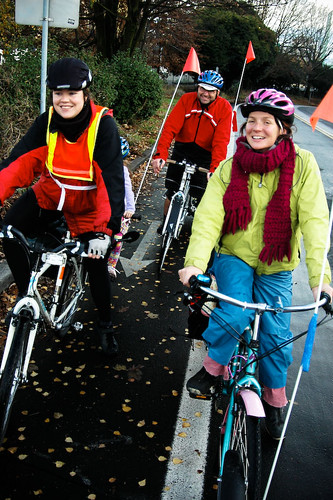This post was written by Kevin Schmidt (MSPT, CMP, Bike PT), licensed Physical Therapist, bike fit specialist, and owner of Pedal PT on SE Clinton.
With the sunny spring weather thousands of new riders are taking to Portland streets. Although pedaling a bike can be a wonderful, empowering, and rewarding experience, more than 80 percent of riders* experience some form of cycling-related pain, numbness, and/or injury- even with short-distance commutes. The good news is a lot of these symptoms are preventable by looking at basic bike fit and pedaling techniques.
Here are some quick tips to help keep you riding more, and hurting less when getting back in the saddle for the first time of the year.
Pedal contact
Regardless of what type of cycling or bike that you ride, always aim to push with the ball of your foot, and centered on the pedal. Using this part of your foot provides the best mechanical advantage for pedaling. Riding self-check: If you find you’re pedaling with the ‘tippy-toes’, it often suggests that your saddle may too high, and that you’re “reaching” at the bottom of the pedal stroke. This can lead to lower back, knee, and/or ankle/calf complaints. Simply lower your saddle in 5mm increments until the ball of your foot naturally finds the center of the pedal.
Knee angle
Believe it or not, but your knees should NOT be completely straight at the bottom of the pedal stroke- a classic new rider misconception, and a great way to develop injury. For optimal comfort, endurance, and injury prevention, aim to have your knee bent roughly 30-35 degrees at the bottom of the pedal stroke, with your heel up slightly (10-20 degrees). A straighter knee can place more stress on the back of the knee and hamstrings, depending on flexibility. Never pedal “heel down” for a prolonged period of time, as this can lead to higher Achilles strain.
Advertisement
Saddle
Generally speaking, the primary goal is to begin with a saddle that is level, as commonly riders will have it tilted a bit ‘nose down’, which dumps more weight on the wrists and hands, leading to numbness/tingling, increased upper arm/neck fatigue, and can also be a factor in knee pain. Self check: With your bike supported (on a trainer or with a partner steadying your bike), sit up on your saddle, hands off of the bars, and just let your body relax and go limp. If you feel you’re sliding forwards, tilt the nose little by little up until you feel level, and that you aren’t going to slide off.
Handlebars and reach
Ultimately, you never want your shoulders reaching farther than 90 degrees (i.e. a right angle from your trunk to shoulders) when you’re flexed over the bike. More upright riders usually don’t have to worry about this, but it’s especially important with road bikes, as anything greater than a 90 degree shoulder angle can lead to neck and mid-back stress, and can also place more pressure on shoulders and hands. Self Check: When starting out, a general rule is to start with your bars equal to (if not higher) that saddle height to bring you more upright to begin. And don’t neglect your posture: aim to keep the lower back flat, with chest elevated to help keep shoulders closer to 90 degrees, and get your head balancing over the shoulders a bit more.
*The statistic comes from a survey of people who did a charity/recreational ride.
— Have bike fit questions? Schmidt is giving a free talk on the topic this Wednesday (4/13).




